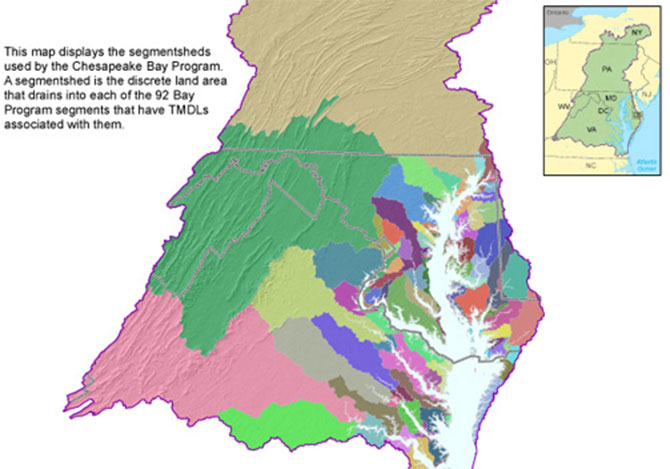There have been several stories in the news about algae blooms, fish kills, and impaired fishing on the Chesapeake Bay as being outward signs of the Bay’s impaired health. Data developed through years of research demonstrate direct and indirect correlations between loading rates of nitrogen, phosphorus, and sediment introduced into the Bay and the negative effects on its general health.
What’s a “Loading Rate?”
“Loading rates” are expressed in terms of weight (or mass) introduced over some period of time (i.e., pounds of sediment per day). Total Maximum Daily Load (TMDL) is when substances, like the ones mentioned above, are introduced into an environment.
Chesapeake Bay TMDL
The “Chesapeake Bay TMDL”—which became law, December 2010—is the pseudonym for Executive Order 13508, and is authorized by the 1972 Clean Water Act. Supported by data and based on extensive modeling efforts, the Bay TMDL prescribes maximum loading rates of 185.9 million pounds of nitrogen, 12.5 million pounds of phosphorus, and 6.45 billion pounds of sediment into the Bay per year—that’s a lot of pounds!
These loading rates are actually well below current actual loadings, and represent the maximum rates at which the United States Environmental Protection Agency (EPA) believes the Bay can naturally assimilate nutrients and sediment while remaining unimpaired. Additionally, the Bay TMDL is implemented through 92 separate TMDLs issued to each Bay tidal segment, or smaller watersheds of the Chesapeake Bay, including pollution limits sufficient to meet state water quality standards for dissolved oxygen, underwater Bay grasses, clarity, and chlorophyll-a.

Among the largest ever created by the federal government—in terms of land coverage and estimated compliance cost—the Bay TMDL impacts approximately 64,000 square miles, including six states and the District of Columbia, which represent all watersheds and tributaries discharging into the Bay.
Timeframe for Meeting Compliance
The timeline for compliance with the Bay TMDL was established in the original order, requiring that by 2025 all measures needed to achieve numerical loading compliance for nitrogen, phosphorus, and sediment must be in place. Interim milestones are designed to measure incremental improvement to provide feedback on the effectiveness of implementation.
How much will it Cost?
Estimated costs for compliance are difficult to measure and vary wildly, in some cases. One estimate suggests the costs for Virginia’s compliance could be between $7 and $10-billion. Another estimate suggests that the combined compliance cost for all six states and the District of Columbia could exceed $700-million on an annual basis. Recognize that compliance costs not only include the one-time expense of infrastructure, but also include ongoing administration, enforcement, inspection, replacement, maintenance, and operation activities.
Learn More
On May 1, 2012, the American Council of Engineering Companies of Metropolitan Washington is sponsoring the Chesapeake Bay TMDL Symposium. Speakers will include state and local officials from Virginia, Maryland, and the District of Columbia.
Also, stay tuned to future blogs. In response to the symposium, I’ll be summarizing the status of these regions’ Bay TMDL compliance programs, as well as the differences between “point source” and “non-point source” discharges.